Related Research Articles
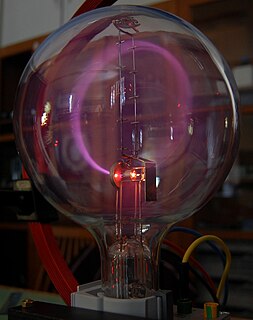
Cathode rays are streams of electrons observed in discharge tubes. If an evacuated glass tube is equipped with two electrodes and a voltage is applied, glass behind the positive electrode is observed to glow, due to electrons emitted from the cathode. They were first observed in 1869 by German physicist Julius Plücker and Johann Wilhelm Hittorf, and were named in 1876 by Eugen Goldstein Kathodenstrahlen, or cathode rays. In 1897, British physicist J. J. Thomson showed that cathode rays were composed of a previously unknown negatively charged particle, which was later named the electron. Cathode-ray tubes (CRTs) use a focused beam of electrons deflected by electric or magnetic fields to render an image on a screen.
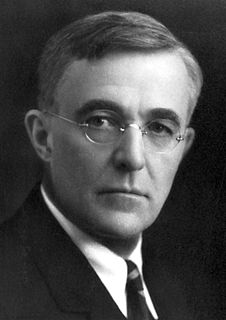
Irving Langmuir was an American chemist, physicist, and engineer. He was awarded the Nobel Prize in Chemistry in 1932 for his work in surface chemistry.

A laser is a device that emits light through a process of optical amplification based on the stimulated emission of electromagnetic radiation. The word "laser" is an acronym for "light amplification by stimulated emission of radiation". The first laser was built in 1960 by Theodore H. Maiman at Hughes Research Laboratories, based on theoretical work by Charles Hard Townes and Arthur Leonard Schawlow.

A fusor is a device that uses an electric field to heat ions to nuclear fusion conditions. The machine induces a voltage between two metal cages, inside a vacuum. Positive ions fall down this voltage drop, building up speed. If they collide in the center, they can fuse. This is one kind of an inertial electrostatic confinement device – a branch of fusion research.
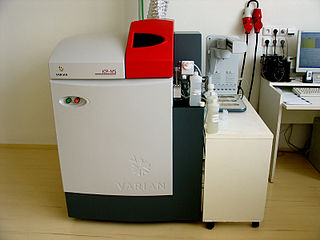
Inductively coupled plasma mass spectrometry (ICP-MS) is a type of mass spectrometry that uses an inductively coupled plasma to ionize the sample. It atomizes the sample and creates atomic and small polyatomic ions, which are then detected. It is known and used for its ability to detect metals and several non-metals in liquid samples at very low concentrations. It can detect different isotopes of the same element, which makes it a versatile tool in isotopic labeling.

Sir Joseph John Thomson was a British physicist and Nobel Laureate in Physics, credited with the discovery of the electron, the first subatomic particle to be discovered.

Inertial electrostatic confinement, or IEC, is a class of fusion power devices that use electric fields to confine the plasma rather than the more common approach using magnetic fields found in magnetic fusion energy (MFE) designs. Most IEC devices directly accelerate their fuel to fusion conditions, thereby avoiding energy losses seen during the longer heating stages of MFE devices. In theory, this makes them more suitable for using alternative aneutronic fusion fuels, which offer a number of major practical benefits and makes IEC devices one of the more widely studied approaches to fusion.
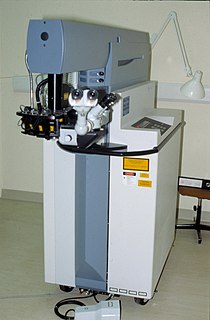
An excimer laser, sometimes more correctly called an exciplex laser, is a form of ultraviolet laser which is commonly used in the production of microelectronic devices, semiconductor based integrated circuits or "chips", eye surgery, and micromachining.

Julius Edgar Lilienfeld was an Austro-Hungarian, and later American physicist and electrical engineer, who was credited with the first patent on the field-effect (FET) (1925). Because of his failure to publish articles in learned journals and because high-purity semiconductor materials were not available yet, his FET patent never achieved fame, causing confusion for later inventors.

Ali Javan was an Iranian-American physicist and inventor. He was the first to propose the concept of the gas laser in 1959 at the Bell Telephone Laboratories. A successful prototype, constructed by him in collaboration with W. R. Bennett, Jr., and D. R. Herriott was demonstrated in 1960. His other contributions to science have been in the fields of quantum physics and spectroscopy.

An electric arc, or arc discharge, is an electrical breakdown of a gas that produces a prolonged electrical discharge. The current through a normally nonconductive medium such as air produces a plasma; the plasma may produce visible light. An arc discharge is characterized by a lower voltage than a glow discharge and relies on thermionic emission of electrons from the electrodes supporting the arc. An archaic term is voltaic arc, as used in the phrase "voltaic arc lamp".
The plasma window is a technology that fills a volume of space with plasma confined by a magnetic field. With current technology, this volume is quite small and the plasma is generated as a flat plane inside a cylindrical space.
Plasma acceleration is a technique for accelerating charged particles, such as electrons, positrons, and ions, using the electric field associated with electron plasma wave or other high-gradient plasma structures. The plasma acceleration structures are created either using ultra-short laser pulses or energetic particle beams that are matched to the plasma parameters. These techniques offer a way to build high performance particle accelerators of much smaller size than conventional devices. The basic concepts of plasma acceleration and its possibilities were originally conceived by Toshiki Tajima and John M. Dawson of UCLA in 1979. The initial experimental designs for a "wakefield" accelerator were conceived at UCLA by Chandrashekhar J. Joshi et al. Current experimental devices show accelerating gradients several orders of magnitude better than current particle accelerators over very short distances, and about one order of magnitude better at the one meter scale.
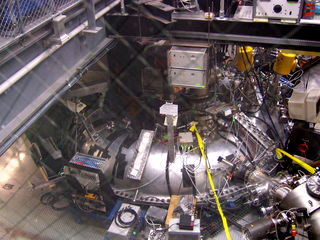
The Madison Symmetric Torus (MST) is a reversed field pinch (RFP) physics experiment with applications to both fusion energy research and astrophysical plasmas.
A TEA laser is a gas laser energized by a high voltage electrical discharge in a gas mixture generally at or above atmospheric pressure. The most common types are carbon dioxide lasers and excimer lasers, both used extensively in industry and research; less common are nitrogen lasers. The acronym "TEA" stands for Transversely Excited Atmospheric.

Sir John Sealy Edward Townsend, FRS was an Irish-British mathematical physicist who conducted various studies concerning the electrical conduction of gases and directly measured the electrical charge. He was a Wykeham Professor of physics at Oxford University.

The environmental scanning electron microscope (ESEM) is a scanning electron microscope (SEM) that allows for the option of collecting electron micrographs of specimens that are wet, uncoated, or both by allowing for a gaseous environment in the specimen chamber. Although there were earlier successes at viewing wet specimens in internal chambers in modified SEMs, the ESEM with its specialized electron detectors and its differential pumping systems, to allow for the transfer of the electron beam from the high vacuum in the gun area to the high pressure attainable in its specimen chamber, make it a complete and unique instrument designed for the purpose of imaging specimens in their natural state. The instrument was designed originally by Gerasimos Danilatos while working at the University of New South Wales.
Denis R Hall FRSE FIEEE FIEE FInstP is a professor of photonics at Heriot-Watt University, Edinburgh. In 2004 he was awarded the Association of Laser Users award for his contributions to the development of industrial lasers and their applications.
Jonathan Harris Orloff is an American physicist, author and professor. Born in New York City, he is the eldest son of Monford Orloff and brother of pianist Carole Orloff and historian Chester Orloff. Orloff is known for his major fields of research in charged particle optics, applications of field emission processes, high-brightness electron and ion sources, focused ion and electron beams and their applications for micromachining, surface analysis and microscopy and instrumentation development for semiconductor device manufacturing.
Ady Hershcovitch is a plasma physicist best known for his 1995 invention, the plasma window, which was later patented.. In the plasma window, a plasma separates air from a vacuum by preventing the air from rushing into the vacuum. This scientific development can facilitate non-vacuum ion material modification, manufacturing of superalloys, and high-quality non-vacuum electron-beam welding. The device has been compared to the force field in the Star Trek TV series. He is well known for his work in plasma physics at Brookhaven National Laboratory. He has over 80 publications and 15 patents.
References
- Plasma state devices, University of St Andrews
- United States Patent 4,698,546 Maitland et al. (6 October 1987) "Apparatus for forming electron beams"